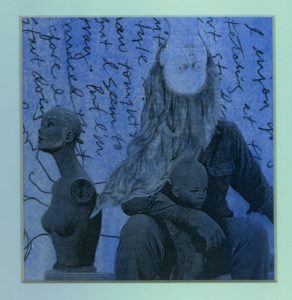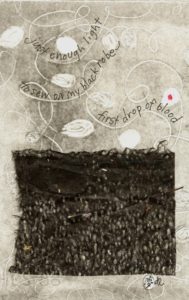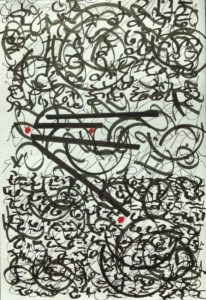
February 6, Tuesday afternoon, 1:00 – 4:00 pm
$15 fee – Limited attendance
This exhibit is open call to members of the North Coast Artist Guild (NCAG), Coast Highway Artist Collective (CHAC), Discovery Gallery, and Artist’s Collective in Elk.
Click here for registration form (word doc). (pdf here).
This exhibit is an opportunity (or challenge) for artists to incorporate writing into their images and writers to incorporate images into their writing. The writing can be any language, real or imaginary, or it can be one recognized symbol or entirely asemic.
The art is not limited to any mediums and can be either two or three dimensional. We are hoping calligraphers, book artists, and writers will submit their script with (or as) “images”, and painters, photographers and ceramists will submit their art incorporating “text”.
Click here for the registration form. The deadline to register is March 26, 2018.
 Words themselves are symbols or pictures of our language; as writing is a method of representing language in a visual or tactile form. All types of writing systems use sets of symbols to represent the sounds of speech, and such things as punctuation and numbers. Writing systems are not only functional as a visual way to represent language, but also represent the cultures and peoples performing the writing.
Words themselves are symbols or pictures of our language; as writing is a method of representing language in a visual or tactile form. All types of writing systems use sets of symbols to represent the sounds of speech, and such things as punctuation and numbers. Writing systems are not only functional as a visual way to represent language, but also represent the cultures and peoples performing the writing.
Though images, pictures, and art are quite different than text of a natural language, they are not totally different. Images, pictures and art are created to convey meaning or express a concept, just as language does when written. In fact, we often draw diagrams to clarify textual meaning. In ancient times, words had magic and power; some words could not be spoken but were represented by a symbol. It can be argued that a graphic display is fully adequate or superior to a verbal or written description.
Artists are notoriously sparing of words, preferring to let their creation “speak for itself.” Yet words can add mystery or additional meaning to an art piece, providing a narrative, leading the viewer to a certain interpretation of the image — or not. Just as an image can supplement a text, words can compliment an image. Then there is the entire concept of script or text altered abstractly to become a piece of art, or the text or script fashioned into an image or picture.
Words are everywhere. Words are on advertisements, appliances, structures, streets, clothing, vehicles, packaging, etc .All these words reflects the environment we live in. The way we speak and write, the vocabulary we use, offers insight into the person we are and the culture or people we are communicating with. Words are necessary and a vital part of our world. For this exhibit we hope to be able to show a diverse rendering of what a Visual Vocabulary looks like.
Images: Feature image by Angie Flannagan. This page, top image, collage by Jan Fogel. Center image, haiga, by donnalynn chase. Image, right, asemic writing by Marcia Brauer.
Further Inspiration:
Per Wikipedia: Asemic writing is a wordless open semantic form of writing. The word asemic means “having no specific semantic content,” or “without the smallest unit of meaning.” With the non-specificity of asemic writing there comes a vacuum of meaning, which is left for the reader to fill in and interpret. https://www.google.com/search?q=asemic+drawing&tbm=isch&tbo=u&source=univ&sa=X&ved=0ahUKEwjyi9KX7ajXAhUE8mMKHSlwDiIQsAQIJw&biw=1304&bih=699
Wosene (Wosene Worke Kosrol) is the first Ethiopian-born painter to transform Amharic script into contemporary abstract art, and these script-images have now become recognized internationally as his ‘artistic signature.’ https://wosene.com/
John Stevens believes “Letterforms and illustration have a long history with artists. I have always thought of myself as an illustrator… who just happens to you use the medium of letters. Each creation with letterforms is an image, not merely words on the page.” http://www.johnstevensdesign.com/calligraphic-illustration/
RETNA ( Marquis Lewis) is a contemporary artist, primarily recognized for graffiti art. He developed a distinctive constructed script which is derived from Blackletter, Egyptian Hieroglyphics, Arabic, and Hebrew calligraphy, as well as more traditional types of street-based graffiti. https://www.artsy.net/artist/retna/works
For Hakuin Ekaku (1686-1769), art was a means to teach the dharma. According to Hakuin scholar Katsuhiro Yoshizawa, “Hakuin’s central concern as an artist was always on expressing Mind itself and Dharma itself. But mind and dharma are beyond the realm of shape and appearance. How do you express them directly?” https://www.google.com/search?q=hakuin+ekaku+art&tbm=isch&tbo=u&source=univ&sa=X&ved=0ahUKEwjMzbyD6KjXAhUQ_WMKHdraBoMQsAQIUQ&biw=1304&bih=699#imgrc=_
An art journal is simply a journal in which art and words are combined to express yourself. It’s all about self-expression and has a long-standing artistic tradition. Artists through the centuries have kept notebooks in which they sketched, practiced, experimented, and recorded themselves. Vincent vanGogh, Picasso, DaVinci, Frieda Kahlo were all prolific “art journalers”. Teesha Moore is a contemporary, prolific art journalist who inspires and teaches a multitude of people. http://www.teeshamoore.com/gallery/
Iranian artist Nasrollah Afjehei (Alfei) believes “calligraphy offers a universal language which does not necessarily have to be read to be understood.” The energy which encompasses his works are universally communicative and emotive. https://www.google.com/search?q=afjehei&source=lnms&tbm=isch&sa=X&ved=0ahUKEwjtoPC2-6jXAhVC02MKHeZIA_sQ_AUIDCgD&biw=1304&bih=699
 Gualala Arts Promoting public interest and participation in the arts since 1961
Gualala Arts Promoting public interest and participation in the arts since 1961